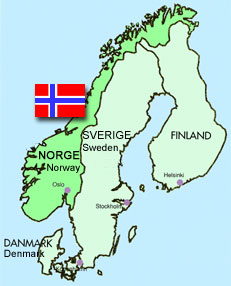
|
|
No other land in the world has such a long, mountainous and deeply cut coastline as Norway. The country is 1750 km long, but is only 430 km across at its widest point. Its, and Europe's, most northern point lies just above 71 degrees north. Norway is a constitutional monarchy and has a population of approx. 4.2 million. |

| 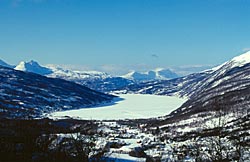 |
Norway's mountainous terrain is awesome and inspiring, but poses many engineering and financial challenges when it comes to building and improving transport infrastructure.
|
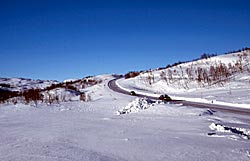 |
Roads hug the contours of the mountainsides, sometimes near the peaks, more often along the shore. The path of least resistance is followed whenever possible.
|
 |
When the way around an obstacle is too long or the cost of building a road prohibitive, one builds a bridge instead. There are lots of bridges in Norway, get the picture?
|
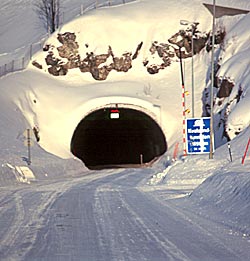 |
A tunnel is often the best way to overcome an obstacle. Long stretches of the road network go through tunnels under fjords or through mountains. As many towns and cities have been built on very uneven terrain, urban road systems have often in recent years been complemented with an often fairly complicated network of road tunnels.
|
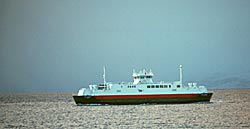 |
A well developed system of ferries is used where wider stretches of water need to be crossed. This substantial investment in transport infrastructure makes it possible for people to live and work in the most remote and otherwise inaccessible locations. One often finds large fishing facilities out on islands which at first glance appear incapable of sustaining human communities.
|
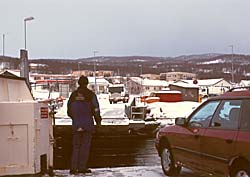 |
A Norwegian schoolchild thinks nothing of taking a boat to and from school.
|  |
Long car journeys in Norway can be rather time-consuming. Air or rail travel can then offer a good alternative. Air travel is well developed in Norway, as is the rail network, which is closely interwoven with the Swedish railway system.
|
This page is a part from a commercial page we made in the past. The original website is closed now but we got the permission to use this part, it would have been a waiste to flush it down the drain. Even if it contains no hunting we belive it is a way to present the great birddoggers paradise that Norway is, provided you have the stamina to climb up and down in the steep mountains.
The English setter is so common in Norway so it is said to be the national dog of the country. However you will find the entire spectra of pointing dogs in Norway, Irish setters, Gordon setters, the Pointer, the Britanny spaniel, Vizla, all the german breeds and much more.
|
NORWAY: THE COUNTRY AND ITS HISTORY
Norway as a commercial partner
Norway has always been associated in the popular mind with fishing and seafaring, and in modern times with crude oil production, but the country's international commerce goes back a long way. The Vikings' light, fast and famously seaworthy longboats carried them around the whole of northern Europe and as far as Iceland, Greenland and America by 800-1000 AD.
The Hanseatic League was founded in the middle of the twelfth century by German merchants in London. - a kind of commercial and political guild aimed at creating a trading monopoly. One could describe it as the European Union of its day. Its creation gradually drew the whole of northern Europe into a common trading area which also included Norwegian cities.
Bergen had its own Hanse office, and both Oslo and Tønsberg were centres of commercial and political significance. Norway became an important supplier of fish and other goods during the Hanse's heyday between 1100 and 1650, developing, with time, great expertise in foreign trade. From the early stages seafaring contributed to the establishment of a busy network of trading relationships with the outside world.
In Viking times Norwegian mariners reached most of north and central Europe and in modern times Norway came to establish one of the world's largest merchant fleets. Today, Norwegian industry is highly efficient and technically advanced, and consequently exports globally not just heavy industrial goods but also electronic and other finely engineered products as well as various types of foods, mainly fish and other seafood of extremely high quality.
Norway's history in a nutshell
The road to becoming a technically advanced welfare state was long, heavy and, at times, bloody. The country's northerly location amid the warming waters of the Gulf Stream results in unstable and unpredictable weather conditions. This, together with its remarkable, possibly unique topography has forced its inhabitants to fight long and hard to achieve progress and development.
The oldest human remains found in Norway go back 8900 years. Studies of these remains show that these people lived mainly on fish, crustaceans and seabirds. It was only first in Roman times (50 - 400 AD) that agricultural society became truly established in Norway.
The country went through a period of rapid expansion, giving rise to many wealthy centres of commerce. By the beginning of the Viking era Norway comprised of a collection of small kingdoms. The Vikings developed trading routes around Europe establishing substantial communities in Ireland and Scotland during the ninth and tenth centuries. Even Iceland and Greenland were colonised.
By the end of the ninth century the whole of Norway had been unified under king Harold Hårfager. The kingdom eventually disintegrated and during the ensuing centuries parts of modern Norway were included in a variety of unions and constellations which included parts of modern Denmark and Sweden. These unions were not always beneficial, being often the result or cause of conflict and economic decline.
After the great Scandinavian war, during which king Karl XII attacked Norway in 1716 and 1718, the country experience a long and largely uninterrupted period of peace up to 1807. Fishing, seafaring and forestry flourished. Economic growth came to a halt in 1807 when Denmark was forced to enter the Napoleonic wars on the French side, and took part in the blockade of Britain. This hit Norway hard, and calls for independence became increasingly strident.
After the treaty of Kiel in 1814 Norway was forced into a union with Sweden under the threat of military attack by the Swedish crown prince, Karl Johan. During this union, Norwegian industry, forestry agriculture and shipping developed rapidly, as did the country's infrastructure as new railways joined previously isolated communities.
The treaty of union with Sweden included a clause which stated that both countries had equal status. This part of the agreement was, however, never honoured by the Swedish government and the Norwegians came to feel that they were being treated as second class citizens.
An open conflict finally developed and became the catalyst for intensive negotiations. The talks eventually collapsed, mainly because of the hard-line attitude of King Oscar II of Sweden. The union was dissolved on June 7 1905. Norway was now an independent kingdom and prime minister Christian Michelsen declared that "Norway now stands at the dawn of a new working day ".
During the following years of peace, Norway developed her system of justice. The reforms of 1907 and 1913 granted female suffrage. A series of new laws established workers' rights, and industrial accident insurance, and in 1915 the working day was limited to 10 hours.
Norway declared its neutrality at the outbreak of the First World War in 1914, but even so lost half her merchant fleet to acts of war. The Second World War hit Norway much harder as the Germans suddenly occupied the country, forcing the King and the government to flee to Britain.
During the post-war era, Norway has developed along the same lines as her Scandinavian neighbours, working actively to establish a common Scandinavian position as regards cultural ties, economic policy, social benefits and employment issues. Norway is also held in high regard for her commitment to international peace, especially through the UN. In contrast to the other Scandinavian countries, Norway has not joined the European Union after its people returned a resounding 'No' in a referendum.
Today Swedes and Norwegians regard each other members of the same family. The border between the two countries is remarkable open, despite the fact that Sweden, unlike Norway, is a member of the European Union. Much economic, cultural and social cross-border activity takes place. There may be customs posts at the more important border crossings to facilitate commercial freight transport, but tens, possibly hundreds of small border crossings remain entirely unmanned - clear proof of the complete trust that these two nations have in each other.
Norway is today a modern, highly developed industrial country that takes advantage of cutting-edge technology in many different areas. Fishing and aquaculture are two such areas where Norway, through efficient use of the latest in research, technology and quality assurance, has earned a solid reputation for producing fish and other seafood of unrivalled quality at competitive prices. This has made Norway into one of the world's leading exporters of seafood.
|